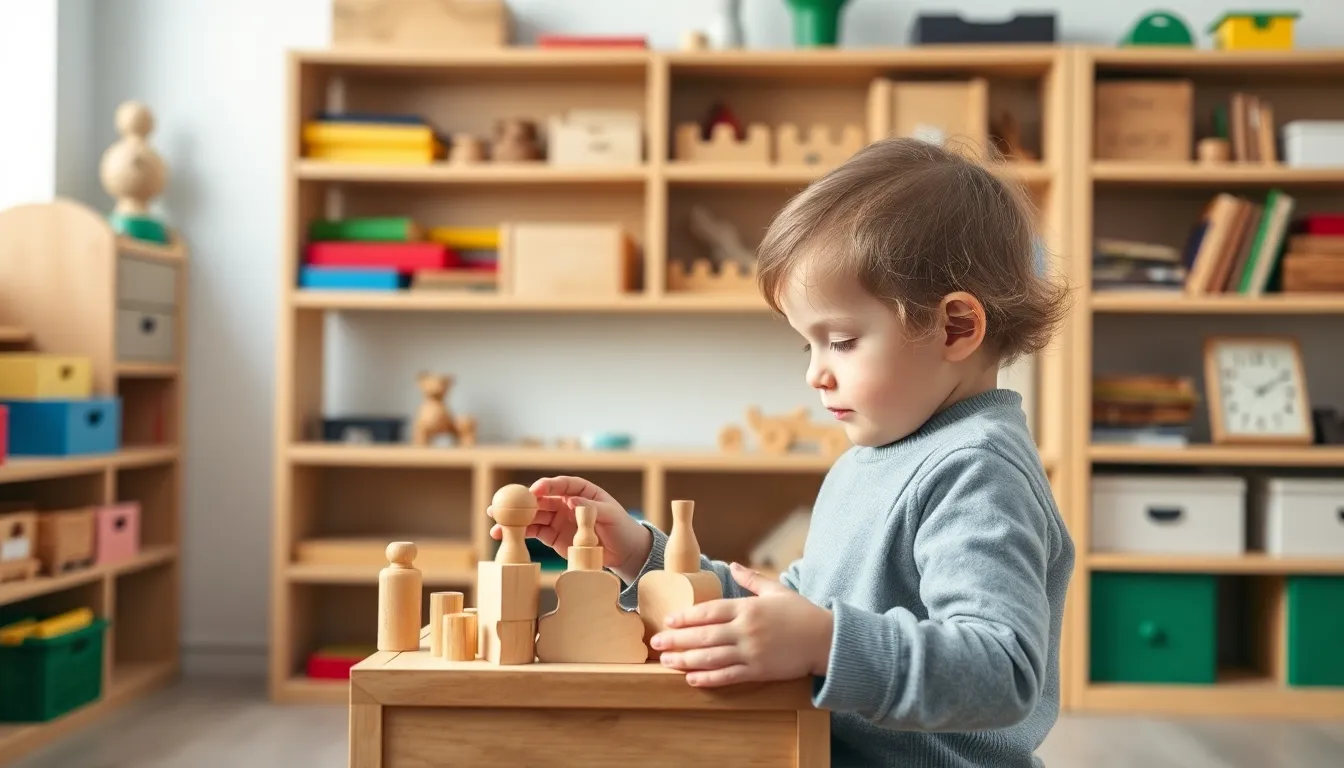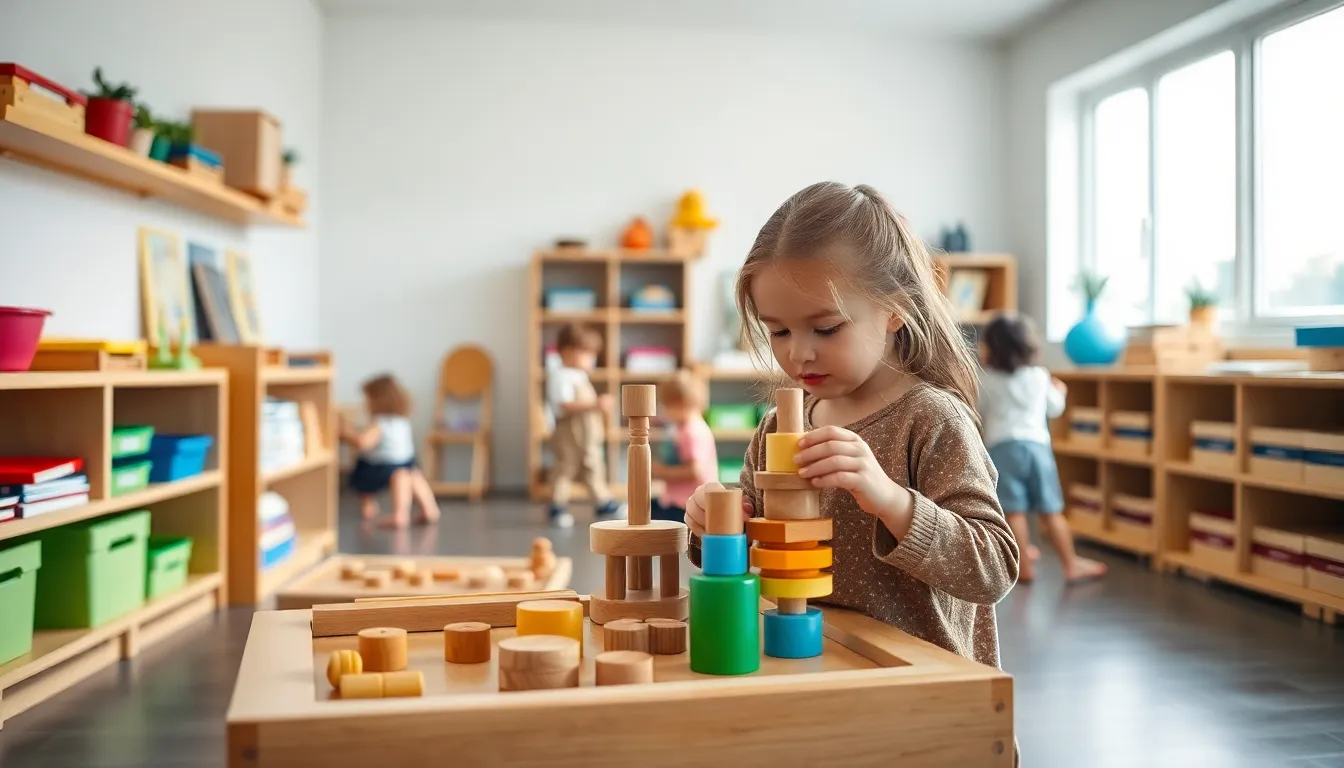Montessori order is a fundamental principle that shapes the learning environment in Montessori education. It emphasizes the importance of organization and structure in fostering a child’s independence and self-discipline. By creating a well-ordered space, children are encouraged to explore their surroundings and engage with materials at their own pace, promoting a deeper understanding of concepts.
In a Montessori classroom, order isn’t just about neatness; it’s about cultivating a sense of responsibility and respect for one’s environment. This approach helps children develop essential life skills, such as problem-solving and critical thinking. Understanding the significance of Montessori order can transform the way educators and parents support children’s growth, paving the way for a more enriching educational experience.
Table of Contents
ToggleUnderstanding Montessori Order
Montessori order is a foundational aspect of Montessori education, emphasizing organization within the learning environment. This principle not only promotes a structured space but also supports children’s autonomy and engagement.
Definition of Montessori Order
Montessori order refers to the systematic arrangement and accessibility of materials in a learning space. This structure allows children to easily find and use resources, fostering independence. In a Montessori classroom, each element, from furniture to learning materials, follows a specific organization, promoting clarity and focus. Such an environment enables children to develop routine and stability, essential components for their growth.
Importance in Montessori Education
Montessori order plays a critical role in enhancing the learning experience. Order cultivates responsibility, as children learn to take care of their environment and materials. It encourages self-discipline by allowing children to choose activities and manage their time effectively. Moreover, a well-ordered classroom enhances problem-solving and critical thinking skills, as children navigate their surroundings with autonomy. Ultimately, embracing Montessori order contributes to a transformative educational journey, equipping children with vital life skills.
Principles of Montessori Order

Montessori order encompasses key strategies that enhance learning experiences through organization and structure. This section explores two foundational aspects: organized learning environments and sequential learning activities.
Organized Learning Environments
Organized learning environments feature systematically arranged materials and resources. Each item has a designated place, which allows children to locate and use them independently. Orderly spaces reduce distractions, enabling children to focus more effectively on their tasks. Furthermore, such environments promote responsibility, as children learn to return materials after use, fostering respect for their surroundings. Effective organization encompasses labeling shelves, grouping similar items, and ensuring easy access to tools, contributing to a calm and conducive learning atmosphere.
Sequential Learning Activities
Sequential learning activities follow a logical progression that builds on previous knowledge. Each activity is designed to develop specific skills, promoting cognitive and physical growth. For example, in mathematics, children might start with simple counting before advancing to addition and subtraction. This incremental approach cultivates confidence and mastery as children engage with concepts at their own pace. By arranging activities in a sequential manner, educators facilitate smoother transitions between tasks, allowing children to establish connections and understand relationships among different concepts clearly.
Implementing Montessori Order at Home
Implementing Montessori order at home involves creating a structured environment that supports children’s independence and curiosity. By organizing spaces thoughtfully, caregivers can enhance learning and exploration.
Creating a Montessori-Inspired Space
Creating a Montessori-inspired space requires intentional organization and accessibility. Designate specific areas for activities, ensuring they are easy to navigate and use.
- Use Low Furniture: Low shelves and tables enable children to access materials independently.
- Choose Natural Materials: Utilize wood, fabric, and glass for a calming atmosphere, fostering engagement.
- Organize by Category: Group similar items—like art supplies, books, and manipulatives—on labeled shelves, facilitating easy identification and use.
- Limit Distractions: Maintain a tidy space to minimize clutter, allowing children to focus on the tasks at hand.
Daily Routines and Organization Tips
Establishing daily routines and organization practices enhances the Montessori approach at home.
- Set Consistent Schedules: Create routines for meals, play, and quiet time, promoting predictability and security.
- Involve Children in Tasks: Assign age-appropriate chores, encouraging responsibility and teamwork.
- Rotate Materials: Introduce new activities periodically while maintaining a core set of familiar resources, sustaining engagement and interest.
- Encourage Reflection: Designate time for children to discuss their activities, reinforcing learning and critical thinking skills.
These methods foster a habit of self-discipline and respect for the environment, aligning with Montessori principles.
Benefits of Montessori Order
Montessori order offers numerous advantages that significantly enhance children’s learning experiences. These benefits include improved focus and independence among students.
Enhanced Focus and Concentration
Montessori order creates an environment where children can concentrate and engage deeply with tasks. Systematic arrangement of materials reduces distractions, allowing children to find resources easily. Clear organization helps maintain attention on activities, leading to extended periods of focused work. For instance, neatly arranged shelves of materials encourage children to explore items of interest without interruption. This clarity promotes a calm atmosphere conducive to learning, whereby children develop critical thinking skills and achieve deeper understanding of concepts.
Fostering Independence in Children
Montessori order fosters independence by empowering children to take charge of their learning. When materials are accessible and organized, children become responsible for selecting and utilizing resources. This self-directed approach enhances decision-making abilities, as they learn to choose activities that align with their interests and developmental needs. For example, children can independently navigate their environment, confidently pursuing projects and tasks without needing constant guidance. This independence cultivates self-discipline, allowing children to manage their time effectively and build essential life skills.
Challenges in Maintaining Montessori Order
Maintaining Montessori order presents several challenges that educators and parents may encounter. These obstacles can hinder the effectiveness of a well-structured learning environment and impact children’s educational experiences.
Common Obstacles
- Inconsistent Organization
Inconsistent organization of materials can disrupt children’s ability to find and use resources. This inconsistency may arise from frequent changes in classroom setup or the improper placement of items.
- Limited Space
Limited space in classrooms or homes can restrict the effective arrangement of materials. This constraint can lead to clutter, making it difficult for children to engage meaningfully with their environment.
- Resistance to Routines
Children may resist established routines that support order. This rebellion can stem from a lack of understanding of the benefits of structure, leading to disruption in learning activities.
- Adult Intervention
Excessive adult intervention can inhibit children’s independence. Constant adult supervision or assistance can create dependencies, preventing children from developing necessary self-management skills.
Strategies to Overcome Challenges
- Regular Assessments
Conduct regular assessments of the learning environment to identify areas needing improvement. Frequent evaluations can help educators make timely adjustments to maintain organization and function.
- Space Optimization
Optimize available space by using vertical storage solutions and multi-functional furniture. Creative arrangements can enhance accessibility and organization, making efficient use of limited areas.
- Modeling Routines
Model routines clearly and consistently to children. Demonstrating the importance of organization through structured activities encourages children to embrace order and recognize its impact on their learning.
- Encouraging Autonomy
Foster autonomy by allowing children to independently select materials and manage their activities. Promoting self-directed exploration helps children build confidence and responsibility.
- Collaborative Cleanup
Implement collaborative cleanup sessions at the end of activities. Engaging children in maintaining order cultivates a sense of ownership and reinforces the importance of an organized environment.
Montessori order is essential for fostering an environment where children can thrive. By prioritizing organization and accessibility, educators and parents create spaces that encourage independence and self-discipline. This structured approach not only enhances focus but also instills a sense of responsibility and respect for the learning environment.
Implementing Montessori order at home or in the classroom supports children’s natural curiosity and promotes critical thinking skills. By addressing challenges and employing effective strategies, caregivers can maintain an ordered space that enriches the educational experience. Ultimately, embracing Montessori order cultivates confident learners who can navigate their surroundings with ease and enthusiasm.




